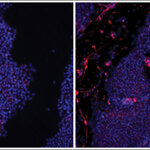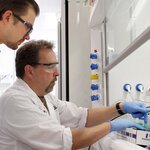Genetics & Molecular Biology

A new study finds that female mice treated with a small molecule that binds to a receptor found on muscle cells speeds up energy metabolism. Sorry males, this does nothing for you.
The molecule is found in tree leaves and the female mice could indulge in high-fat foods without gaining weight or accumulating fat.
Research has shown that a hormone called brain-derived neurotrophic factor (BDNF), which is secreted after physical exercise, controls body weight gain by eliciting signals to suppress food intake and enhance energy expenditure. Manipulation of this signaling represents a…

Gene expression, the process by which our DNA provides the recipe used to direct the synthesis of proteins and other molecules, is how we develop and survive.
To-date, science has made breathtaking progress, studying one single gene at a time, but a new approach developed by Harvard geneticist George Church, Ph.D., can help uncover how tandem gene circuits dictate life processes, such as the healthy development of tissue or the triggering of a particular disease, and can also be used for directing precision stem cell differentiation for regenerative medicine and growing organ transplants.
The…

Scientists have discovered a new hormone that fights the weight gain caused by a high-fat Western diet and normalizes the metabolism - effects commonly associated with exercising.
Hormones are molecules that act as the body's signals, triggering various physiological responses. The newly discovered hormone, dubbed "MOTS-c," primarily targets muscle tissue, where it restores insulin sensitivity, counteracting diet-induced and age-dependent insulin resistance.
To test the effects of MOTS-c, the team injected the hormone into mice fed a high-fat diet, which typically causes them to grow obese…

Researchers have identified distinct immune changes in patients diagnosed with chronic fatigue syndrome, known medically as myalgic encephalomyelitis (ME/CFS) or systemic exertion intolerance disease.
This is
the first robust physical evidence that ME/CFS is a biological illness as opposed to a psychological disorder, and the first evidence that the disease has distinct stages and could help improve diagnosis and identify treatment options for the disabling disorder, in which symptoms range from extreme fatigue and difficulty concentrating to headaches and muscle pain.
The researchers used…

Enzymes are the workhorses of our bodies, they make biochemical reactions happen faster than they otherwise would and sometimes essential reactions would not happen at all without them.
The Rubisco enzyme, the most abundant protein on the planet, has one of the most significant responsibilities in life on Earth - the conversion of carbon dioxide to organic compounds, the building blocks of all plant and animal cells.
Given its importance, it is also something of a mystery, because after untold ages of evolution, it is thousands of times less efficient at its job than most other…
Low birth weight is indicative of various problems and fortunately modern science has made it possible for more low-birth weight babies than ever to thrive, survival is over 94 percent for children born in the third trimester of pregnancy.
But low birth weight is being linked to residual effects and in a new paper researchers find that underweight infants may eventually become the grandparents of children at a higher risk for metabolic problems like high cholesterol, diabetes, and obesity, according to a new study.
The researchers started with two groups of rats. One of these…

Hemochromatosis (HH) is the most common genetic disorder in the western world, and yet is barely known outside biology. In the US 1 in 9 people carry the mutation, though not necessarily the disease.
Caused by problems in hepcidin – the liver hormone that controls the body iron levels – the disease causes an overload of this metal and toxic, and potentially fatal, iron deposits on the patients’ organs. Treatment is regular bleedings to eliminate the surplus metal, with more severe cases taking up to 50 pints (29 liters) a year.
This might be an effective solution but s everything but…

New transcriptome data for underutilized legumes means underappreciated crops could soon become valuable tools in agriculture.
Thousands of species belong to the legume family, the Fabaceae, yet only a few of them are used in mainstream agriculture. Dozens more are underutilized. Unlike soybean, peanut, chickpea, and other chart toppers, the underutilized species can grow in areas of very poor soil with limited water availability. This is because they are equipped with unique variations in plant growth genes that have been lost from mainstream crops through years of breeding.
New genetic data…

It's been over 50 years since the first experimental use of adult stem cells - bone marrow transplants - began, and in that time over 1,000,000 hematopoietic stem cell (HSCT - cells isolated from the blood or bone marrow that can renew themselves and differentiate to a variety of specialized cells) transplantations (have been performed in 75 countries, but there are striking variations between countries and regions in the use of this lifesaving procedure and high unmet need due to a chronic shortage of resources and donors that is putting lives at risk.
HSCT, commonly known as…

Human pluripotent stem cells, which include both human embryonic stem cells(hESCs) and adult stem cells like induced pluripotent stem cells (iPSCs), need large numbers for transplantation into patients but the process of translating their potential into effective, real-world treatments involves deciphering and resolving a host of daunting complexities, according to a new study.
The authors say they have definitively shown that the culture conditions in which stem cells are grown and mass-produced can affect their genetic stability.
Human pluripotent stem cells are cultured in several…